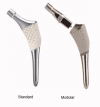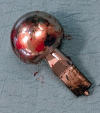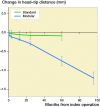Unexpected varus deformity and concomitant metal ion release and MRI findings of modular-neck hip stems: descriptive RSA study in 75 hips with 8 years' follow-up
- PMID: 33297800
- PMCID: PMC7919878
- DOI: 10.1080/17453674.2020.1853387
Unexpected varus deformity and concomitant metal ion release and MRI findings of modular-neck hip stems: descriptive RSA study in 75 hips with 8 years' follow-up
Abstract
Background and purpose - Modular-neck hip stems have been identified with corrosion-related problems from the neck-stem junction. We report an ongoing varus deformity of modular-neck hip stems with simultaneous metal ion release observed during a study comparing the migration of modular vs. standard hip stems.Patients and methods - We followed 50 patients with modular and 25 with standard neck stems using radiostereometry (RSA). At 5-year follow-up, we noted a compromised integrity of the modular stem with varus deformity in the neck-stem interface. Changes in head-tip distance as well as whole-blood ion concentration and MRI findings were analyzed. The modular stems were followed further up to 8 years.Results - The head-tip distance decreased continuously by 0.15 mm per year resulting in 1.2 (95% CI 1.0-1.4) mm at 8 years for modular stems, while for the standard stems at 5 years, the decrease was 0.09 (CI 0.0-0.2) mm or 0.02 mm/year. For the modular stems, the reduction in head-tip distance correlated to the increase in whole-blood cobalt concentration at 8 years but not to the MRI grading of tissue reactions. At 5 years, cobalt levels were 4.9 µg/L for modular stems and at 8 years 4.8 µg/L, whereas for standard stems this was 1.0 µg/L. After 8 years, 9 of 72 stems had been revised for different reasons, but only 1 with obvious adverse local tissue reaction (ALTR).Interpretation - We present a surprisingly large progressive deformation at the modular neck-stem junction, but so far without a definite clinical problem. Even the femoral head seems to show slight compression onto the taper over time. A high rate of revisions for the modular type of this stem has raised general concerns, and it has been recalled from the market.
Trial registration: ClinicalTrials.gov NCT01512550.
Figures







References
-
- Atwood S, Archibeck A, Patten E W, Bozic K J, Pruitt L A, Ries M D.. Corrosion-induced fracture of a double-modular hip prosthesis: a case report. J Bone Joint Surg Am 2010; 92(6): 1522–5. - PubMed
-
- Barrack R L. Modularity of prosthetic Implants. J Am Acad Orthop Surg 1994; 2(1): 16–25. - PubMed
-
- Duwelius P J, Hartzband M A, Burkhart R, Carnahan C, Blair S, Wu Y, Grunkemeier G L.. Clinical results of a modular neck hip system: hitting the “bull’s-eye” more accurately. Am J Orthop 2010; 39(10 Suppl.): 2–6. - PubMed
Publication types
MeSH terms
Substances
Associated data
LinkOut - more resources
Full Text Sources
Medical
